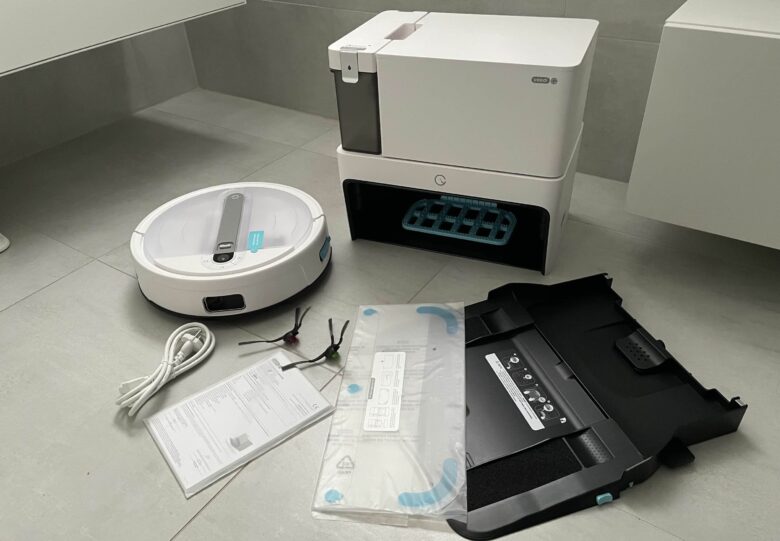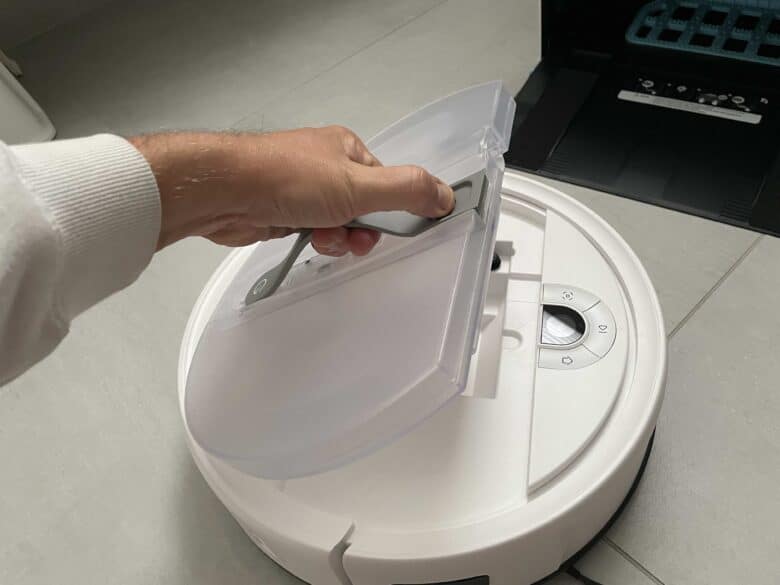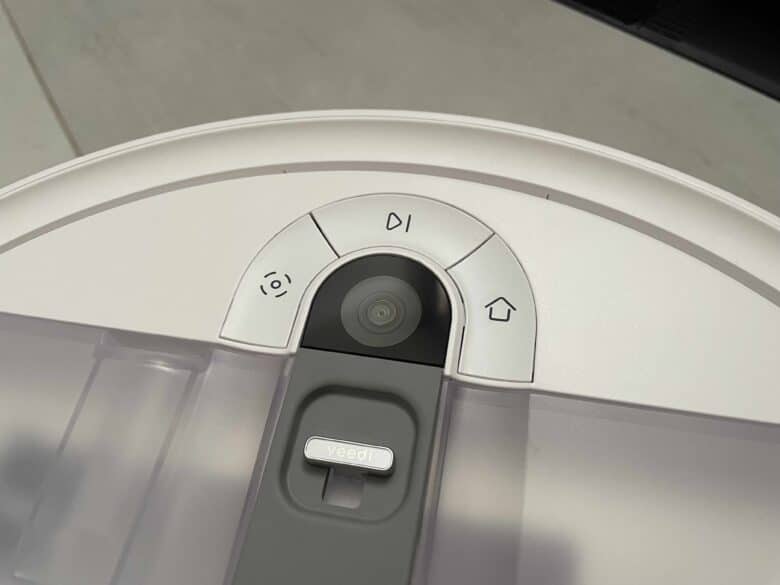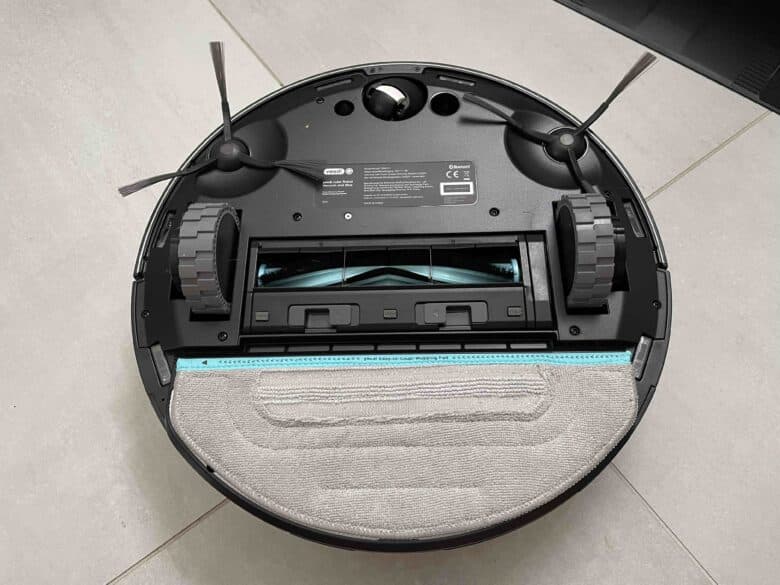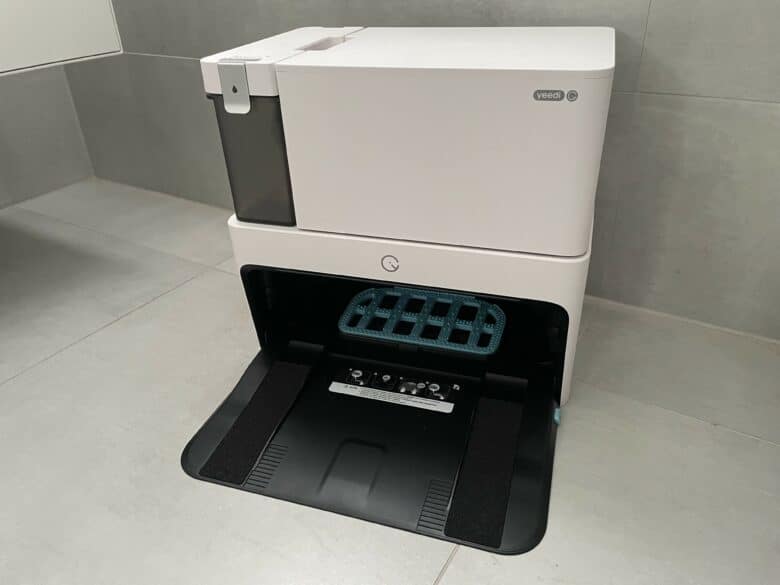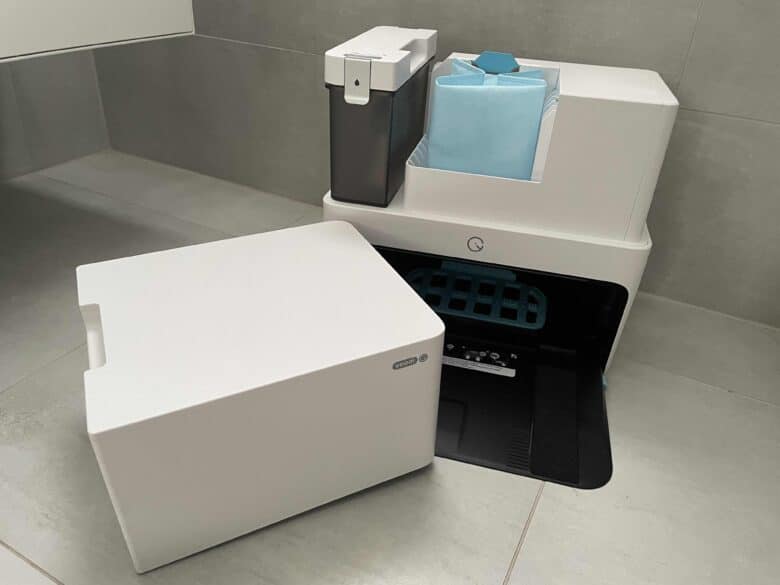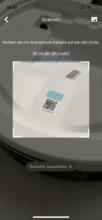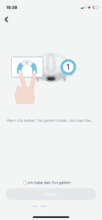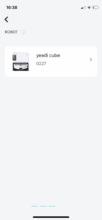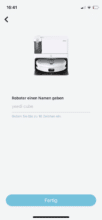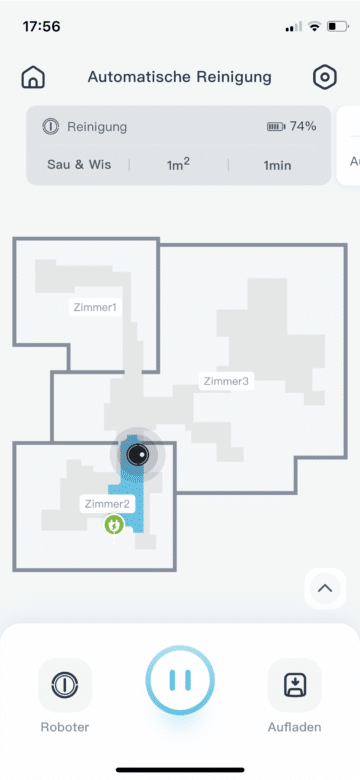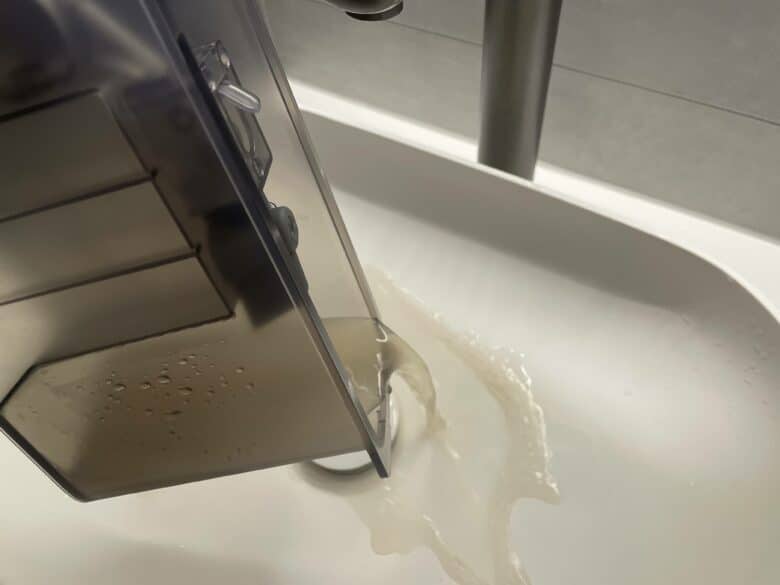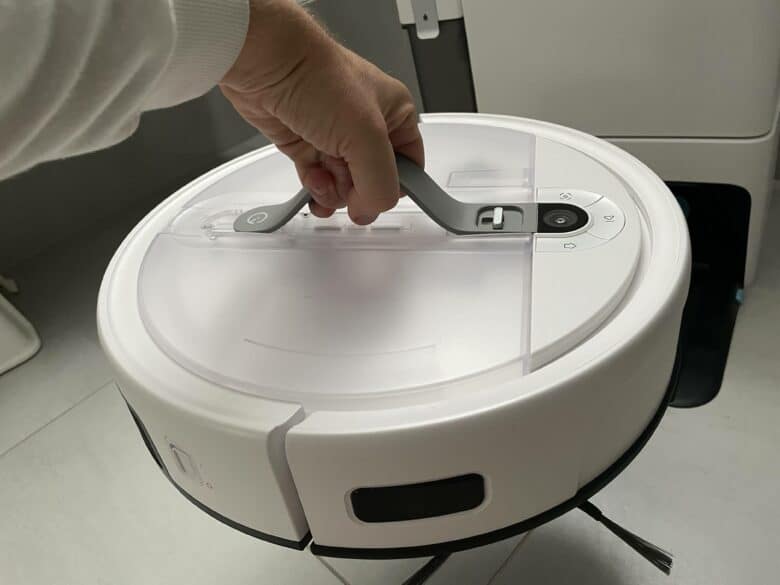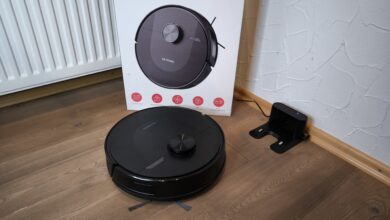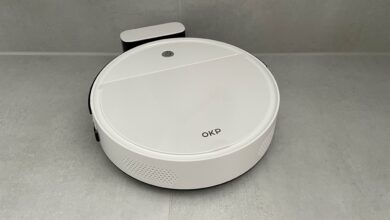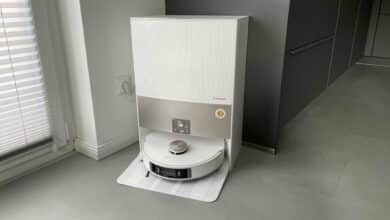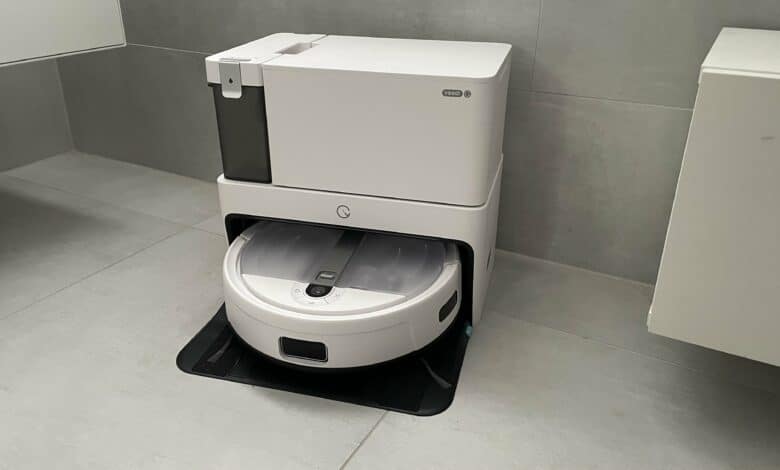
Robot vacuum cleaners have now reached the masses of society. Many people rely on the daily support of the smart household helpers. It is therefore not surprising that the manufacturers are tempted to launch better and better models on the market. Particularly in terms of user convenience, model after model is being taken up a notch. This is most clearly demonstrated by robot vacuums that come with a base station including cleaning and suction functions. Here, you only have to take care of your robot vacuum cleaner every few days. The rest is done on your own. The Yeedi Cube also offers such a station. However, unlike many competing models, it is rather compact. Whether this leads to performance losses and how it otherwise does against the flagships of Roborock, Dreame and Co, we check in the Yeedi Cube test.
New flagship from the house of Yeedi
Yeedi has always been considered the low-budget king when it comes to manufacturing vacuum robots. Cheap everyday helpers like the Yeedi Vac 2 Pro (test) and the Yeedi Vac Hybrid (test) make that clear. The company from the Far East has already proven that it can also do things differently with its Yeedi Floor 3 Station (test). This not only came in a noble design, but also scored with a terrific price-performance ratio. With the Yeedi Cube, the Chinese manufacturer has now gone one step further. This is the latest flagship, which is the first model from Yeedi to offer a base station with cleaning and suction function.
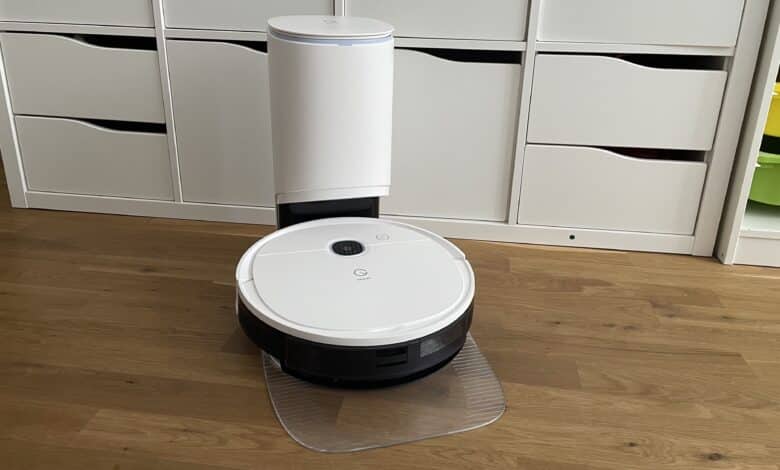
Unlike the Floor 3 Station, the Cube comes with an entirely different wiping unit. While the Floor 3 with its two rotating mops is based on the Yeedi Mop Station (test), the Cube relies on a classic mop surface. This is supposed to exert pressure on the floor through special sonic technology, which should ensure effective cleaning. This is strongly reminiscent of the Vac 2 Pro. In general, it seems as if Yeedi has used its price-performance hit as a basic concept. Thus, the Cube is also pleasingly flat by dispensing with LiDAR sensor technology. The in-house VSLAM technology is supposed to be used for navigation.
Much more exciting than the wiper unit and navigation technology will certainly be the all-in-one station for most people. Here, not only the dust bin is emptied. On top of that, the wiping cloth is cleaned and even dried following the cleaning tour. At first glance, it is noticeable that the Yeedi Cube is pleasantly compact and could thus outdo many models from the competition. After all, it is not always just the high price that deters many potential buyers from a vacuum robot with a corresponding station. The large format is also a thorn in the side for some. Let’s start with the test and check whether the plan of the Chinese works out.
Technical data
| Dimensions | 34 x 34 x 8 cm |
| Suction power | 4,300 pascals |
| Navigation | Visual and Laser Fusion Navigation |
| Mopping-Type | Auto-Lift Sonic Mopping (8mm liftable) |
| Water tank | 1 liter |
| Dirty water tank | 1.2 liters |
| Vacuum cleaner bag | 2.1 liters |
| Battery | 5,200 mAh (up to 150 minutes runtime according to Yeedi) |
| Control | Yeedi App, Amazon Alexa, Google Assistant |
| Base Station | OMNI station with cleaning, suction and drying function |
| Price | 699.99 euros |
Yeedi Cube test: scope of delivery
Yeedi Cube test: design and workmanship
If you take a look at the robot vacuum cleaner itself, you will at first wonder how Yeedi comes up with the epithet Cube. After all, this one relies on a classic circular design. However, the detectives among you will quickly understand that it is not the smart household helper itself that the manufacturer is referring to. The base station is responsible for the name. Even though it is strictly speaking more of a cuboid than a cube, I find the name really well chosen. After all, especially laymen can quickly lose track of the robot vacuum market. After all, one is always confronted with epithets like “Ultra” or “Pro” here.
Even though the robot vacuum cleaner itself has clear parallels to the Vac 2 Pro in technical terms, it is then visually very different from its spiritual predecessor. With a diameter of 34cm and a height of 8cm, it is 1cm narrower and 2cm lower than Roborock’s current flagship Roborock S8 Pro Ultra (test). Why this is so, you do not have to question long. For example, by not using LiDAR navigation, Yeedi saves a corresponding “turret” on the top. Those who own a lot of flat furniture will certainly be happy about the low build height. Yeedi relies on plastic for the material, which feels pleasingly resistant. In general, the build quality is on a high level.
Yeedi Cube Test: UFO water tank on top
While the Vac 2 Pro comes with a clean white finish, the Cube is anything but white on the top. Instead, we glimpse a transparent vessel here. This is the water tank that is used in the wiping function. Considering its saucer-like design, it is hardly surprising that Yeedi calls it the UFO water tank. This is surprisingly voluminous with a capacity of 1 liter. If you want to remove it from the device, you just have to press the lock switch and lift the handle afterwards.
When it comes to the water tank, Yeedi has a leg up on even the high-priced competition from Roborock and Dreame. Personally, at least, I have yet to see a robot vacuum that can boast this considerable volume. The tank is surrounded by a white matte rim. Matte white is also the defining color on the rest of the device. That is very pleasing. After all, experience has shown that vacuum robots with a glossy look tend to scratch. The best example is certainly the top of the Uwant U200 (test).
Furthermore, we find a total of three different buttons on the top. These are the usual suspects. With “Home” you send the Cube to its base station. “Clean” starts the cleaning process at the push of a button. You can activate an area cleaning via “Spot Cleaning”. The robot vacuum’s camera is located right next to the trio of buttons. This offers the VSLAM technology known from the Vac 2 Pro, which is used for mapping and navigation.
Yeedi Cube test: bottom side without wipe pads
A look at the sides doesn’t reveal any big surprises. An industry-standard bumper is used on the front. This is supposed to protect the smart household helper and your furniture from damage. Furthermore, there are ventilation slots and an on/off button. Last but not least, we can find the button for removing the dust container on the side. Opening it is wonderfully easy. In doing so, I could see that there is already a HEPA filter inside the device from the factory. Anything else would have been scary considering the lack of a replacement filter in the scope of delivery. Time to take a look at the underside. Here, admittedly, I was a bit disappointed at first. After all, I wasn’t expecting a simple wiping surface from Yeedi’s latest flagship.
Finally, this is the manufacturer of the groundbreaking Mop Station (test). This set off a real trend a few years ago. Thus, Yeedi moved away from the rigid mop surface and gave the vacuum robot two rotating mops. Meanwhile, high-priced flagships from other manufacturers such as the Ecovacs Deebot X1 OMNI (test) or the Dreame L10S Ultra (test) also rely on the rotating mop pads. In view of the experience-based better cleaning performance, one can definitely understand this. We’ll clarify whether the decision has a negative impact on the wiping performance later. Furthermore, there are two side brushes and various sensors on the underside. Besides the drop sensor and carpet sensor, Yeedi places a floor tracking sensor here. This is supposed to improve the VSLAM navigation compared to the Vac 2 Pro.
Yeedi Cube Test: The OMNI Station
Yeedi’s all-in-one solution earns its name from the cleaning or suction station and its cube or cuboid design. The base station may not be the most compact, but the manufacturer still manages to design it in such a way that it doesn’t look too bulky in the living space. With dimensions of 37.2 x 26.5 x 24.0 cm, it is clear that this squeegee may take up some floor space. Unlike many other models, however, it is not too tall. When placed correctly, this allows the smart household helper to blend in wonderfully unobtrusively with the living room ambience. The base station of the Cube can be divided into different sections. First, there is the removable base. This is about the same size as the robot vacuum itself and serves as a support surface, so to speak, to keep your floor from getting wet.
The installation is very easy. You just have to slide it into the opening of the station until it clicks into place. More exciting, however, is the upper part of the station. Here you’ll find the dirty water tank, which is located on the left side. On the right, in turn, you’ll find the dust container. Like almost all manufacturers of comparable all-in-one solutions, Yeedi also relies on a dust bag here, which has a volume of 2.1 liters. To be honest, I find this trend neither customer- nor environmentally friendly. It would be much better to make the bag solution optional. That way, allergy sufferers can use a bag if necessary. However, I don’t want to blame Yeedi negatively for this. After all, this seems to be common practice in the industry by now.
Furthermore, there is a status LED on the station, which makes it possible to register problems without an app. Some might miss a fresh water tank. But this is where the UFO water tank described above comes into play. Yeedi takes a completely different approach to the fresh water supply and simply places the corresponding tank on the robot vacuum itself. Like the robot vacuum itself, the station also scores with a solid design and high build quality. I hardly have any reason to complain here. Nevertheless, I find the looks of models like the X1 OMNI or Roborock S8 Pro Ultra simply more coherent. However, we are also in a completely different price category.
Yeedi Cube Test: Commissioning
The installation of the Yeedi Cube is pleasantly self-explanatory. After unpacking everything, you should first connect the OMNI station to a power outlet. You can switch on the vacuum robot itself via the On/Off button on the side. Now the smart household helper tells you that you can scan the QR code of the device to synchronize it with the Yeedi app. Before you get started, I would first put the robot in the station. Since you’ll also be taking a first drive through your home as part of the commissioning process, it’s advantageous if the battery is fully charged. Here, you have the choice of placing it in the station yourself or letting it drive in automatically by pressing the home button. Once the battery is full, you can start the setup via app.
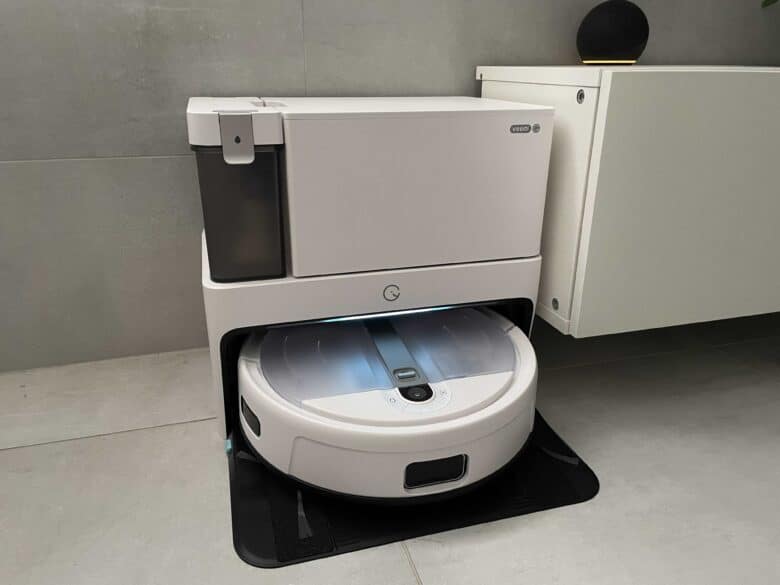
I am already familiar with the Yeedi app. Have I them but among other things with the Yeedi Floor 3 station can use. After creating an account here and clearing privacy issues, you can add the Yeedi Cube as a new device. To pair the robot with the app, simply scan the QR code on the device. Now the Yeedi Cube is transferred to your home network. This is a pleasantly uncomplicated process, as the app supports you with its practical step-by-step instructions. Once the smart household helper is in your network, the first step is to update the firmware. Once the device is up to date, you can control it via app.
Yeedi Cube Test: The Yeedi App
In theory, you can use the Yeedi Cube without an app. However, I strongly advise you not to. After all, you need the manufacturer’s smartphone app just to effectively map your own four walls. Only when the vacuum cleaner has familiarized itself with your home can it also perform its cleaning in a targeted manner. Accordingly, it is also the mapping that you initiate first when the app and the robot vacuum cleaner have been synchronized. After the smart household helper has completed its maiden voyage and mapped the cleaning area, you can access the corresponding floor plan in the app.
In this case, the software already automatically divides your apartment into different rooms. This can go wrong with complicated floor plans. However, this is not a big deal. After all, you can still make adjustments in the map. In my case, the automatic subdivision worked perfectly. By the way, you can save several floors within the mapping. This is especially interesting for house dwellers or people in a duplex apartment.
Yeedi Cube test: many setting options
After the Yeedi Cube mapped my living space, I was able to familiarize myself a bit with the app features. The first thing I noticed was that the software is pleasantly clear. You can easily make cleaning settings. And there are many of them. For example, you can create a cleaning schedule. That way, the smart household helper always goes on a cleaning tour automatically at a certain time. You can also set up restricted zones or let the robot vacuum clean in a specific area. Furthermore, you can specify where the Yeedi Cube should only vacuum, only mop or do both at the same time.
On top of that, the intensity of the wiping or suction function can be regulated. You can choose from a total of three different power levels for both. I think it’s really cool that you can set your own cleaning mode for each room. For example, bathrooms and kitchens, which usually have tiles, can be cleaned with full suction power and maximum water flow rate. On the other hand, if you have parquet flooring in the living room or other living spaces, you can turn down the mopping function for that room or turn it off altogether. Detailed settings can also be made for the station. For example, you can regulate how long the washing time of the mop should be. You can also regulate the subsequent drying phase. The app completely convinced me in the test. Here Yeedi is in no way inferior to the competition.
Yeedi Cube test: navigation with VSLAM
The Yeedi Cube is not an ultra-flat vacuum robot. However, considering that the 1 liter water tank sits on top, the 8 cm height is quite astonishing. However, the manufacturer has to pay a high price for the rather flat height. Finally, Yeedi does not rely on LiDAR technology, which is now common in almost all mid-range and high-end models, for its Cube. Instead, the company relies on VSLAM for navigation. This camera-based technology not only reduces the device height, but also the production costs significantly. Unfortunately, VSLAM could not really convince me in previous tests and I noticed partly serious disadvantages compared to the reliable laser technology of LiDAR sensors. To get navigation problems of the previous models out of the way, Yeedi wants to have worked properly on the algorithm.
Personally, the result surprised me quite positively. The only clear loss I feel here is in the speed. It simply takes much longer for the device to find its way around with the VSLAM camera than when the room is measured at lightning speed with laser beams. After the familiarization phase, however, it navigated quite reliably through my apartment. There was no sign of chaos here. For example, it found doors purposefully in order to continue in the next room. In one discipline, it is even a nose ahead of some models with LiDAR sensors. It drove to within a few millimeters of my walls. This allowed it to reach even the stuck dirt in the corner between the floor and the baseboard. So all in all, the VSLAM navigation worked quite well.
Yeedi Cube test: disadvantages in the dark
Personally, however, I would always rely on LiDAR sensors. After all, these offer a very decisive advantage in dark rooms or at night. While the VSLAM technology based on camera images namely requires light to ensure good navigation, a vacuum robot with LiDAR technology also navigates precisely through a room with absolute darkness.
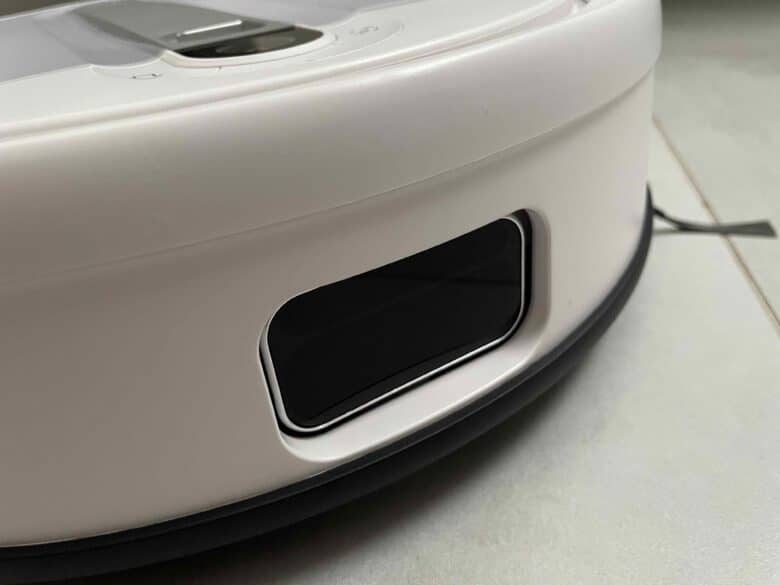
Since the robot also uses laser technology for its object recognition anyway, orientation in the dark should probably be better than it still was with the Vac 2 Pro, for example. If you want to be on the safe side, however, the first mapping by the Yeedi Cube should definitely be carried out in the best possible lighting conditions.
Yeedi Cube Test: Object Detection
In addition to the VSLAM camera, the Yeedi Cube uses other little helpers to assist it in driving through your home. Above all, the object or obstacle detection plays a major role. After all, nobody wants shoelaces or cables to be eaten. Yeedi probably relies on infrared sensors here, which in turn are supposed to detect obstacles in time to enable evasion.
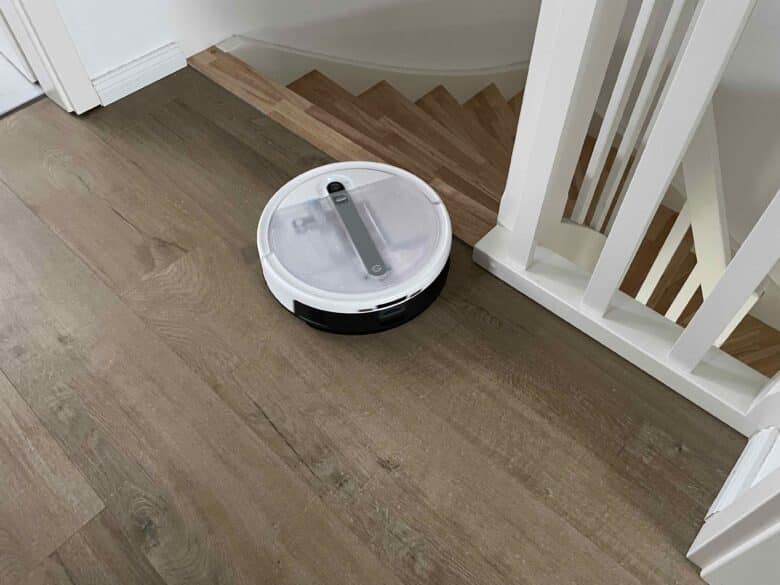
With larger objects like shoes or books or a ball, this worked quite well. With smaller things, however, the Yeedi Cube had problems with obstacle detection, just like many other vacuum robots. For this reason, you should, for example, smaller toys of your children or cables accordingly secure.
Yeedi Cube test: cleaning performance
Now we want to come to the supreme discipline of vacuum robots – the cleaning performance. As part of an extensive field test, I put both suction and wiping performance of the Yeedi Cube under the microscope.
Wiping unit with ultrasound
The wiping unit of the Yeedi Cube is once again based on an exciting ultrasonic technology, which we also know from the Vac 2 Pro. However, the manufacturer has apparently sat down on the seat of its pants again and made some exciting revisions. This already starts with the wipe itself. Its texture has been adjusted and is supposed to provide for a stronger scrubbing of the floor. Yeedi has also made improvements to the speed.
A whopping 2,500 vibrations per minute speak to a promising wet cleaning of your floors. In practice, that certainly pays off. Thus, the Yeedi Cube also coped with stubborn jam stains. The smart household assistant had an even easier time with fresh liquids on hard floors like juices or similar. Of course, it can’t keep up with the cleaning results of competing models with two mop pads.

Nevertheless, I was extremely positively surprised. If a stain was ever not completely mopped up, you simply send the robot back to the spot. By the way, the Cube’s wiping plate can not only vibrate. It can also be raised by 8 mm. This has the advantage that the smart household helper can drive over carpet without wetting it. In this price range, this is anything but a matter of course!
Base station
After the cleaning tour is complete, the robot vacuum returns to its station. Even in between, the device returns to the station to have the cloth cleaned. You can regulate the intervals at which this happens in the app. You can choose between 10, 20 or 30 minutes.
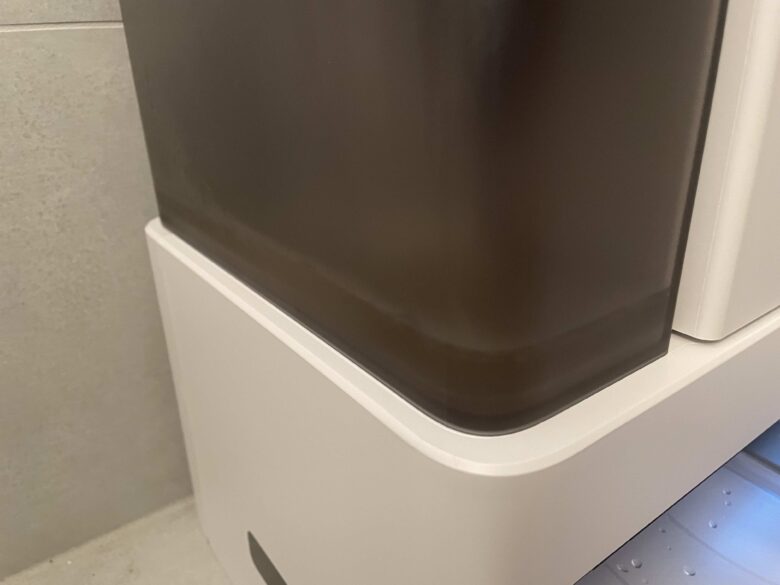
Here, some models of the competition act smarter. These do not rely on time, but cleaned square meters as the interval between cleanings. Once in the station, the dust bin is vacuumed as well as the cloth is properly rinsed and cleaned.
Once that is done, the all-in-one solution uses 40°C hot air to dry the wiping surface. This ensures hygiene and prevents foul odors. Here you have the choice between 3 and 5 hours drying time.
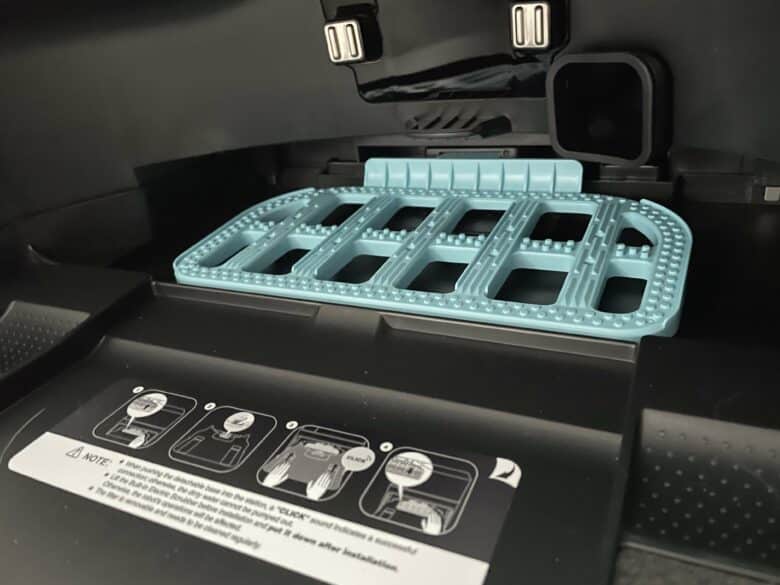
When vacuuming the dust container, you have to reckon with a lot of noise. However, since the whole thing is done after a few seconds, this should not bother you in everyday life. On the other hand, those who want to let the robot vacuum run at night should keep that in mind.
Suction power
With a maximum suction power of 4,300 Pascal, the Yeedi is amazingly powerful. However, the high suction power is also accompanied by a rather high operating volume. That’s why Yeedi offers three different suction levels at once. Between the two modes “Quiet” and “Normal”, I honestly could not determine any major differences. These provided solid cleaning results, but also left some room for improvement. The “Max” mode then showed that the Yeedi Cube can also do things differently. Thus, the strong performance in combination with the rubberized main brush and the two side brushes provided a really good cleaning. Only in some corners did the robot vacuum still leave small remnants of dust and other dirt.

But we know that from high-priced competitors, too, and it’s usually due to the circular design of vacuum robots. On hard floors like tiles, vinyl or parquet, the Yeedi Cube does a great job. It also does a convincing job on carpets. Unlike many other models in this price range, it doesn’t just drive around them, but can drive over them thanks to the liftable wiping unit. However, if you have a long-floor carpet, you shouldn’t rely too much on it staying dry. Here, the distance is simply not enough. The cleaning results on the carpet were okay. As a pet owner, I only had to note that the vacuum robot sometimes struggled with pet hair.
Yeedi Cube test: user comfort
Anyone who buys a robot vacuum cleaner with a cleaning and suction station is usually looking for an extra portion of user comfort. Is this also the case with the Yeedi Cube? Let’s first take a look at the robot vacuum itself. Yeedi has built in an exciting feature that will especially appeal to people who want to clean several floors with the robot. On the top, there is a practical carrying strap that allows you to comfortably carry the smart household helper to its place of use. This not only looks cool, but to my knowledge is also a real novelty in the field of vacuum robots.
Furthermore, of course, the automatisms of the Cube station provide convenience. Thus, it not only cleans the wipe, but on top of that, it takes care of the collected dirt in the dust bin. The transparent design of the dirt and fresh water tanks is also useful. This means you can always see whether it needs to be emptied or refilled. Some people might only find refilling the fresh water tank a bit crampy. After all, you have to bend down to the robot itself to remove and fill the tank. This didn’t really bother me, but older people should keep this in mind.
Yeedi Cube review: maintenance
And what about maintenance? Even though you’re getting an all-in-one station here, you’ll of course have to do it yourself from time to time. This includes emptying the waste water. You also have to replace the dust bag with a new one at regular intervals. Yeedi itself says that a bag should last 60 days before it needs to be replaced. Furthermore, you should take a look at the wear parts on the underside every few weeks. The side brushes in particular can become quite frayed after a few months and should be replaced. You should clean the sensors on the side and underside as well as the VSLAM camera every now and then. This way, you create the best conditions for the robot vacuum to function well. Last but not least, you should not forget the filters. Both in the robot and in the station there are HEPA filters, which should be cleaned or replaced in case of emergency.
Yeedi Cube review: battery life
The Yeedi Cube is not a marathon runner. However, the battery life should be perfectly adequate for average users. On the middle of the three power settings, I was able to use it for just under 90 minutes before the battery reached its limits. The battery life should be considerably longer on the lowest level. If you have several floors to clean, you should keep the quite limited runtime in mind. If the robot vacuum runs out of energy reserves while cleaning a floor, it simply continues its cleaning tour at the last cleaned spot after the battery is fully charged.
Conclusion
Has Yeedi succeeded in debuting in the all-in-one solutions sector? I think the Yeedi Cube is a complete success in many ways. It already starts with the unusual but cool design and continues with a great build quality. Furthermore, the device scores with a great wiping performance, which I would not have expected from the wiping plate. The suction function also achieves great results. It only has its problems on long-pile carpets from time to time. Furthermore, you get a clear app with many setting options offered here.
The Achilles’ heel of the Cube is the navigation. Although the VSLAM technology delivers much better results than, for example, a Vac 2 Pro did, LiDAR is and remains the non-plus-ultra when it comes to navigation of vacuum robots. Certainly, the abandonment also has a lot to do with cost savings. After all, Yeedi would then never be able to offer this device at an MSRP of under 700 euros. Nevertheless, those who do not want to do without LiDAR and, on top of that, prefer rotating wiping pads in the wiping function should take a closer look at the similarly priced Uwant U200.
Yeedi Cube
Workmanship & design
Cleaning performance
Navigation
Value for money
86/100
The Yeedi Cube convinces with a compact design and a solid cleaning performance in the test. Unfortunately, navigation is a problem.
